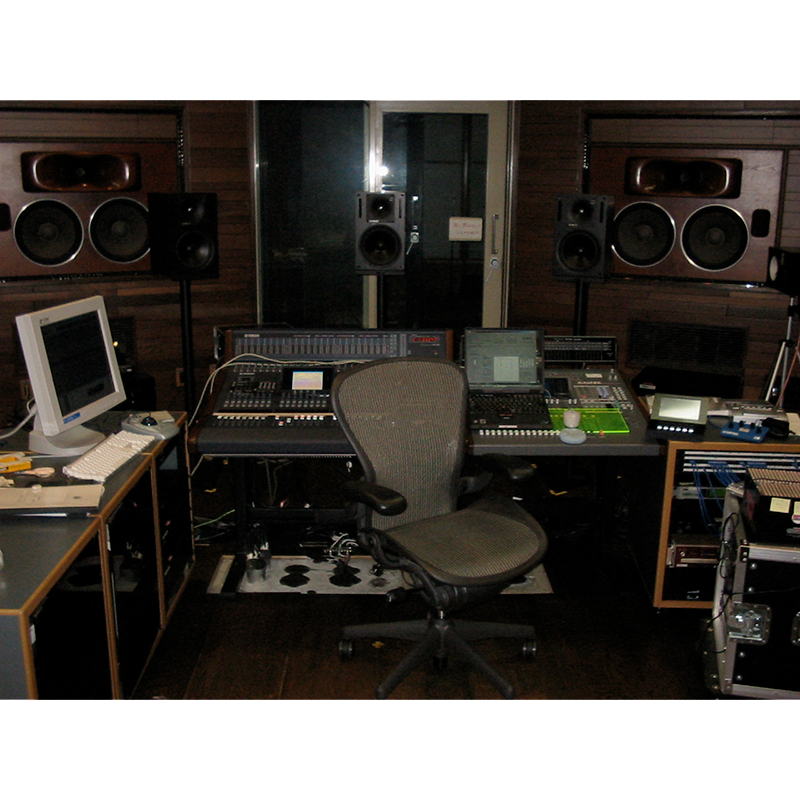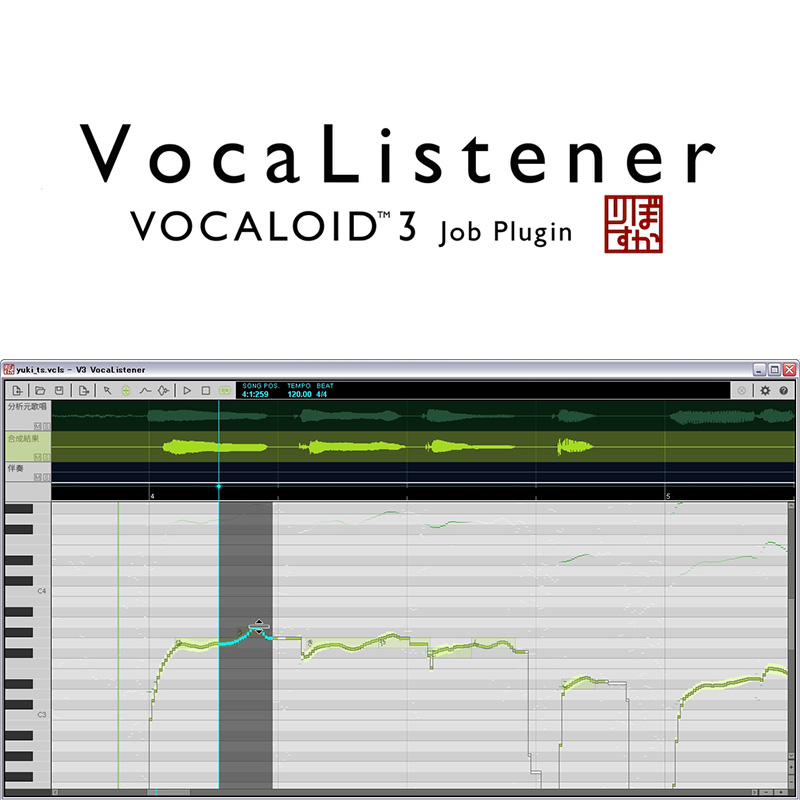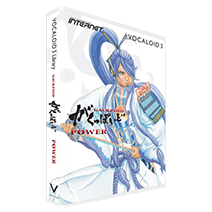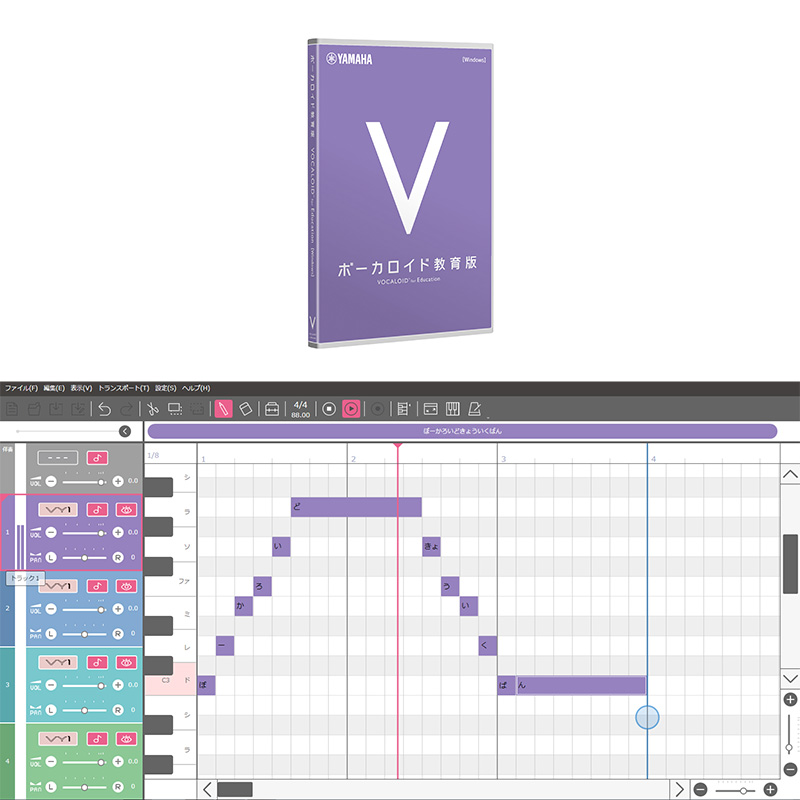History
20 years of VOCALOID history
Ever wonder how VOCALOID came about and how it was developed?
Let’s take a close look at the 20-year history of VOCALOID.
Dawn 黎明期
VOCALOID development goes into full swing

In the last year of the 20th century, Yamaha started development of a technology codenamed “Daisy," the predecessor of VOCALOID. Although the company had developed a wide range of electric instruments—from synthesizers to electric guitars, drums, wind instruments, and violins, there was one instrument it had not yet tackled, the human voice. So, in 2000 Yamaha embarked on the journey to synthesize vocals, and R&D started in a corner of Toyooka Factory in Toyooka, Shizuoka.
Click here for an interview with a developer about an episode that occurred when development started.
VOCALOID is first revealed at Musikmesse

VOCALOID was first announced at Musikmesse, one of the world’s largest music industry trade shows, held in Frankfurt, Germany. Engineers around the world took great interest in this novel technology that synthesizes the singing voice.
VOCALOID(1) is launched to the general public at the NAMM Show

Leon and Lola—English vocal libraries developed by ZERO-G and the first VOCALOID products—are released at the NAMM Show, a music industry trade show in California, US. The trade show marked the launch of VOCALOID (1) to the general public.
Meiko, the first Japanese vocal library, was released by Crypton Future Media in November 2004. Both products were unexpected hits on the bedroom music production market at the time. Featured illustrations of VOCALOID characters, the style of the packages had a big impact and continued to be used on subsequent products.




Kaito, the second Japanese vocal library released by Crypton Future Media. The pioneering male Japanese vocal library remains popular to this day.
Also, in this year, the video platform “Nico Nico Douga”, which had a huge impact on the development of VOCALOID, was born.

VOCALOID2 is released and Hatsune Miku is born

The year 2007 is widely recognized as one of the most epoch-making years for VOCALOID. Featuring clearer pronunciation, VOCALOID2 was released at the NAMM Show in the beginning of 2007. Hatsune Miku, which uses that edition, was released by Crypton Future Media on August 31 that year.
Hatsune Miku attracted attention as a next-generation diva due to her immense adaptability and unique character. She was widely used in bedroom music production and became a platform for original contents on the Nico Nico video sharing site. Everything came together with perfect timing and Hatsune Miku quickly became a huge hit. A large number of songs using VOCALOID for the main vocals came out online, marking 2007 as the start of “vocaloid culture.”



VOCALOID songs grow and evolve
With the momentum of 2007 showing no signs of slowing the number of vocaloid songs posted online continued to grow, with many different approaches in evidence. Songs making use of rapid singing in a manner difficult for humans to achieve appeared around this time, and VOCALOID became to become a world of its own.
It was then that Internet Co., Ltd. launched Gackpoid, the first product based on a male voice for the VOCALOID2 engine. The product was designed to faithfully reproduce the voice of famous Japanese singer and actor Gackt. Thanks also to the illustration by manga artist Kentaro Miura on the package, the product drew wide attention and in the three days following its launch nearly 200 songs using Gackpoid appeared online.


Development 発展期
Use cases expand with NetVOCALOID service

The NetVOCALOID service launched as a SaaS service that provides the singing synthesizer function online using the VOCALOID engine on a server. Thanks to Hatsune Miku and Gackpoid, VOCALOID’s popularity now transcended the category of bedroom music production, but steep hurdles remained for people wanting to use the product, such as the computer specifications required. Crypton Future Media and Internet Co., Ltd. launch Miku to Utaou (Let’s Sing with Miku) and Mobile Phone Gackpoid through the service with the aim of allowing more users of all ages and genders to experience VOCALOID. Young people who didn’t have computers and other users who balked at the price of the package edition were thrilled at this innovation of being able to use VOCALOID on a flip phone. NetVOCALOID greatly expanded the possibilities for VOCALOID and played a role in growing the range of users.
VOCALOID songs rapidly become more sophisticated in terms of both songcraft and music videos. Many of the hit VOCALOID tunes that are still popular in 2024 were released in 2009.






・To get a a more natural synthesized sound, we formulated the hypothesis that perhaps we should use natural language that has meaning instead of meaningless sounds that sound like a some spell, and set to work.
VOCALOID is released as an app and breaks into games

iOS-compatible iVOCALOID VY1 released. Equipped with a piano roll interface like those used in computer DAW software and a function that lets you email the songs you create, the app offered true integration between your computer where you created the song and your smart device. iVOCALOID VY1 used the VY1 voice, but more versions were created thereafter, including VY2, Aoki Lapis, and Merli.
KONOMI’s Metal Gear Solid Peace Walker was equipped with a function that uses the NetVOCALOID service system to let players create and sing songs in-game, and in 2010 VOCALOID broke into the game industry.
Around this time companies began to launch a large number of vocal libraries. Quirky libraries also appear like Gachapoid—a voicebank based on Gachapin, a popular character from a kids’ TV show in Japan. 2010 was also the year Yamaha started selling vocal libraries developed in-house under the Yamaha brand.








VOCALOID3 is released, now smoother and intended for the global market

Launch of VOCALOID3. The new version featured improved rapid singing and smoother interval and tone changes. It was compatible with five languages—Chinese, Korean, and Spanish in addition to the standard Japanese and English—making it a more global software application. Another noteworthy feature in terms of user experience was the addition of limitless undos.
The VOCALOID3 launch was announced on Nico Nico in a 53-hour live-stream. The reason for making it 53 hours was that the “V” in VOCALOID is the number 5 in Greek numerals and this was the third version of the software.














VOCALOID joins Cool Japan
VOCALOID songs can be created by singing

The VOCALOID Trans-Pacific Project was selected for the Ministry of Economy, Trade and Industry’s 2012 Cool Japan Strategy Promotion Program, which aimed to promote Japanese media content as a way to revitalize the Japanese economy. According to the data, the number of posted VOCALOID songs for the 2010s reached its peak in 2012—testimony to the overwhelming momentum at the time.
VOCALOID3 Job Plugin VocaListener is launched, a plugin usable on VOCALOID3 Editor. This popular, unique plugin lets you set VOCALOID parameters by singing, to create synthesized vocals.











More apps are created that use VOCALOID
VOCALOID Editor now compatible with Mac

With the transition to smartphones proceeding apace, Yamaha developed a proprietary app as well as the iVOCALOID SDK for non-Yamaha companies.
For example, SEGA’s Uta Yomi 575 is an app in which words entered in a traditional 5-7-5 poem format are read by two characters, Azuki Masaoka and Matcha Kobayashi. (The vocal libraries made for Uta Yomi 575 led to the creation of the VOCALOID4 voicebanks Azuki and Matcha). Meanwhile, Vocalodama is a mobile game proprietarily developed by Yamaha based on VOCALOID vocal synthesizer technology that uses VY1.
2013 was also saw the launch of a product for Nintendo 3DS using VOCALOID is launched. Called Daigasso! Band Brothers, the game uses VOCALOID technology to make the avatar “Artist” sing.
On the other hand, “VOCALOID Editor for Cubase NEO” editor has finally become Mac compatible after 10 years.








VOCALOID4 is released
eVocaloid technology is developed

VOCALOID4 Editor and VOCALOID4 Editor for Cubase released. They are equipped with features such as greatly improved creative capabilities and user-friendliness, a “growl” effect, and "Cross Synthesis" that lets you mix multiple vocal libraries. It remains very popular in 2024, with many people using it as their main editor. VOCALOID4 Editor for Cubase, known as "VocaCu" in Japan, was used by many creators for to its incredibly smooth music-making capabilities and a workflow that integrates with Cubase.
Pocket Miku was launched under Gakken’s Adult Science Magazine series, and featured the NSX-1 sound source chip, which is equipped with eVocaloid, an LSI embedded version of VOCALOID.
In addition, SEGA released an app that using VOCALOID technology for the PS Vita called Uta Yomi 575. VOCALOID was now offered on a broad range of platforms as a matter of course.













App launched to make music anytime, anywhere
The number of voicebanks released reach its peak

Launch of the Mobile VOCALOID Editor iOS app. This app featured a greatly improved user interface and expanded functions compared to iVOCALOID, allowing users to create complete songs using just a mobile app. Thanks to an editing function on par with desktop editors as well as separately purchasable voicebanks, this software allowed people to fully experience VOCALOID anytime, anywhere. In fact, some creators create music using just Mobile VOCALOID Editor and the standard apps that come with their mobile phone. See this page for details.
2015 was also saw the release of the Sachiko voice library, a vocal library based on the late Sachiko Kobayashi, one of Japan’s biggest traditional pop and enka singers. Yamaha analyzed Kobayashi’s kobushi and shakuri techniques (traditional Japanese singing techniques similar to vibrato and glissando) and included a specialized Job plugin with the app called Sachikobushi that allows you to easily reproduce her singing voice with VOCALOID. Although Kobayashi had been active on the internet, many users were amazed at the VOCALOID version. Representing a new frontier for VOCALOID that connects real and online worlds, the Sachiko voice library remains one of the most popular libraries today.
2015 saw the most releases of vocal libraries ever, including Sachiko.






























Nearly every week we would record, test, and re-record.
There were a lot that never even went to market.
VOCALOID enters game industry with VOCALOID SDK for Unity

The iOS app, Mobile VOCALOID Editor, launches. It features a greatly improved user interface and expanded functions compared to iVOCALOID, allowing users to create complete songs with just a mobile app. Thanks to an editing function that is on par with desktop editors and separately purchasable voicebanks, it allows people to fully experience VOCALOID anytime, anywhere. In fact, some creators only use Mobile VOCALOID Editor and standard apps that come with their mobile phone to make music. See this page for details.
2015 was saw the launch of the Sachiko library, a vocal library based on the late Sachiko Kobayashi, one of Japan’s biggest traditional pop and enka singers. Yamaha analyzed Kobayashi’s kobushi and shakuri techniques (traditional Japanese singing techniques similar to vibrato and glissando) and included a specialized Job plugin with the app called Sachikobushi that allows you to easily reproduce her singing voice with VOCALOID. Kobayashi had already been active on the internet, but many users were amazed at the VOCALOID version. Representing a new frontier for VOCALOID that connects real and online worlds, it remains one of the most popular vocal libraries today.
2015 saw the most releases of vocal libraries ever, including Sachiko.











VOCALOID for Education launches
VOCALOID Keyboard (VKB-100) launches

Yamaha launched VOCALOID for Education, a software application for Widows OS computers and tablets that optimized VOCALOID for educational use. VOCALOID for Education let users learn how to make music intuitively in a fun way through trial and error, without needing to read music. Many elementary schools incorporated it into music lessons, and the lineup has since been expanded to be compatible with iPads and other platforms. It continues to evolve to this day as a digital education trailblazer.
Yamaha launched the VKB-100 keyboard, which used the embedded VOCALOID-board hardware that was announced in 2010. Designed around on the concept of “preforming songs,” the VKB-100 can be worn over the shoulder, allowing the user to play the keyboard with their right hand while applying singing effects with their left. It includes the VY1 vocal library, along with the option of adding the Hatsune Miku, Megpoid, IA, and Yuzuki Yukari libraries.
The VKB-100 retains a strong fan base even today, with limited-edition models designed in collaboration with events like Magical Mirai released on occasion. For a detailed look at the specifications, click here for the product page.










・For the voicebanks that came standard in VOCALOID5, we held auditions with a focus on talented vocalists to take full advantage of the new Attack & Release effect feature.
Maturity 成熟期
VOCALOID5 is released

VOCALOID5 released, featuring a revamped version of the VOCALOID4 UI. It is equipped with many new features to improve creator workflow, such as the "Style" function that lets you make presets of your favorite tones by combining effects, and an "Attack & Release" effect that lets you visually select vibrato and other effects. This was also the first version VOCALOID that could be used standalone on a Mac, and the first to include voicebanks in the editor. The standard version came standard equipped with four voicebanks and the premium with eight.















AI Hibari Misora is announced and VOCALOID:AI is released
Yamaha’s deep learning based-VOCALOID:AI technology announced to the world for the first time. The technology was used to create "AI Hibari Misora," which was used to reproduce the late Misora Hibari’s voice in an NHK special. Misora Hibari was an extraordinary entertainer who continued to top the traditional Japanese pop charts. To commemorate the 30th anniversary of her passing, it was decided to hold a "live" performance of a new song sung by her. Yasushi Akimoto produced the new song, which was performed by recreating her voice with AI technology and displaying a life-size 4K 3D hologram of her on stage.
This project of producing a new song by a deceased singer left a huge impact, heralding a new era of AI technology.
For more details, please check this news release.


VOCALOID Collection is started

DWANGO Co., Ltd. held the first VOCALOID Collection contest, which was held twice yearly thereafter, and continues to grow as a gateway to success for aspiring VOCALOID producers.
This year, we focused on research and development.
・I rooted for the first VOCALOID Collection with all my heart!
"Charlie" is launched

In 2021, Yamaha launched Charlie, a communicating robot that can sing and talk. Charlie comes equipped with VOCALOID singing synthesis as well as automated songwriting technology. Yamaha’s involvement as a musical instrument manufacturer in the creation of a communicating robot attracted coverage from television and a variety of other media outlets..
Yamaha began developing VOCALOID6 around this time.
VOCALOID6 is released, equipped with AI technology

With AI-based speech synthesis technology suddenly starting to gain attention, Yamaha released VOCALOID6, equipped with a newly developed AI-based engine. This version includes features that greatly expanded the range of creative expression over the previous version such as being able to switch the language of a single voicebank between Japanese, English, and Chinese, along with the "VOCALO CHANGER" function, which converts a creator's vocal data into VOCALOID vocals. Retaining the previous synthesizer engine while adding a new AI engine that utilized a revamped synthesizing process, this new version offered more options to creators. It marked the start of a new era for Yamaha’s VOCALOID.
“Become a VOCALOID voicebank!” auditions for singers who want their voices made into VOCALOID voicebanks were held in collaboration with the music collaboration app nana from nana music, Ltd., marking the first time selection of vocalists had been open to the general public since the launch of Aoki Lapis in 2012. Over 3,000 people applied for the auditions, and grand prize winner philo-san’s voice was released in 2023 as the voicebank "Fuiro."
VOCALOID wins the Good Design Long Life Award and Kodansha Publication Culture Award.





・The first image of the VOCALOID6 screen people saw was the thumbnail on the Good Design Award we won the week before.
・We were actually looking to release the voicebank from the nana auditions in VOCALOID6.
・VOCALO CHANGER PLUGIN & β-STUDIO activities start, and VX-β is offered to a limited release

Yamaha’s research division launched VOCALOID β-STUDIO as an experimental initiative. The initiative's main theme was to conduct pilot tests involving external creators, and it drew wide attention from users. The VX-β pilot test was open for a limited period of time and to a limited number of people, and the number of applicants greatly exceeded the maximum. As the first version since VOCALOID4 to offer seamless integration with Cubase by Yamaha-subsidiary Steinberg, VOCALOID β-STUDIO greatly enhances the user experience.
The VOCALO CHANGER plugin launched, offering an evolved standalone version of VOCALO CHANGER, which was built into VOCALOID6. This unique plugin reconstructs the creator’s vocals into AI voicebank vocals in real time, expanding the possibilities for making music on VOCALOID.









Future 未来
The future of VOCALOID, 20 years after launch
Incorporating the results of the “β-STUDIO” activities from the previous year, new AI voice banks for VOCALOID6 were released one after another, the prototype plug-in “VX-β” was distributed free of charge as an add-on to VOCALOID6, and the sales of VOCALOID products began at Plug In Boutique, a major VST plug-in software distributor, and other ambitious activities continued in various fields.
In August, Crypton Future Media also announced plans to release VOCALOID6 versions of Hatsune Miku, and this drew even more attention to the future of VOCALOID.
The singing voice synthesis market is more exciting than ever, and when I think about the future of VOCALOID, I can't stop getting excited.
What can we create for the future?
We ourselves are always challengers.
I hope that we can continue to walk together with everyone for the next 20 years.
















